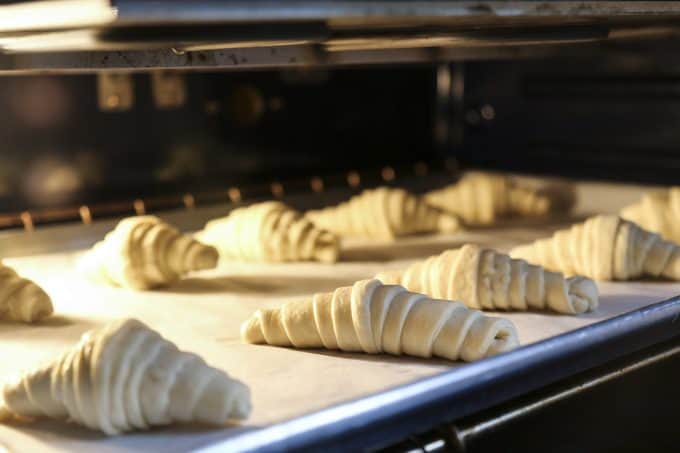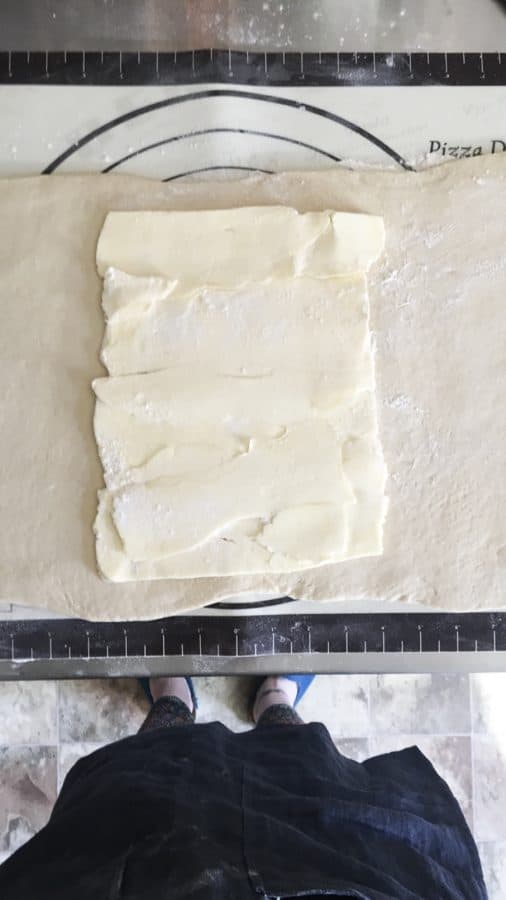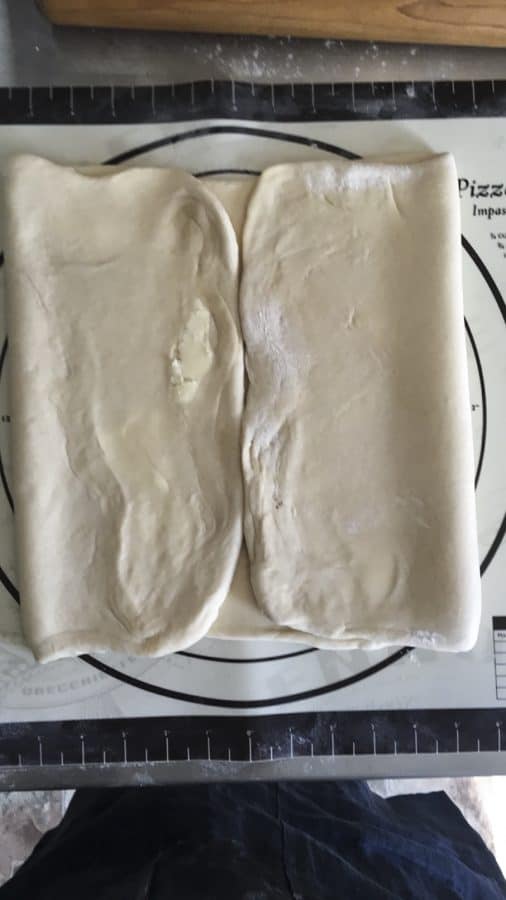So many of you have asked me to do a tutorial, and I’m so happy to break down How to Make Croissants for you. Between the video and the Cook’s Notes, you should be able to wow yourself and your friends and family with a bread basket full of flaky, buttery, deep brown croissants.
For more fantastic Bread Recipes, visit our special Homemade Bread page!
There is a mystique surrounding croissants. Everyone knows they’re flaky, buttery, and delicious, but few people venture into making croissants for themselves because they’ve got a reputation for being fussy and difficult.
I get it. Anything that requires a couple of days of planning before hand can sound off-putting and intimidating.
Here’s the thing, though; there is really nothing in the wonderful world of baking quite like a homemade croissant that you’ve just pulled out of your own oven. It is so worth it the work.
Many American bakeries have some sort of complex regarding blonde croissants. In their fear of overcooking the pastry, they end up with a poor, pale, under-cooked shadow of a piece of pastry that cannot compare to a mahogany coloured croissant with an exterior so flaky that it showers crumbs when you tear it apart or bite into it.
The soft chew of the many interior layers provides the contrast to that deep, dark, shatteringly toasted outer layer. It’s perfection when it’s done right.
…And doing it right isn’t hard when someone breaks down the steps for you. I’m here to help you out, folks.
Watch the video, and let me break it down for you here. I am here to show you how to make croissants!
I cannot think of something that makes a special occasion better than a basket full of homemade pastry. The dough used in our homemade croissants recipe is -quite handily- the same dough used in our classic and irresistible Pain Au Chocolates {Chocolate filled croissants or Chocolatines}.
It is also the dough used for a couple of forthcoming recipes here on Foodie with Family. Once you’ve mastered this dough -and I do promise it isn’t that hard even if it takes a bit of a time commitment- the world of pastries is yours to grab!
Normally, our Cook’s Notes come right before the recipe, but because today’s How to Make Croissants tutorial is a little lengthy, and these notes are important to help you through the process, I’m moving them up top. Be sure to keep them in mind as you move into making croissants.
Cook’s Notes
- There is NO substitute for butter. None. Nada. Negatory. Zip. Zilch. No shortening. No coconut oil. No tub margarine. I’ve heard it said that you can make this with vegan butter sticks, but I haven’t tried it, so I can’t possibly recommend it. We’re talking about traditional, from-scratch French pastry here, and the French? They love that butter.
- Speaking of butter -because there is a lot of it in today’s recipe- please don’t use salted butter. You want to control the amount of salt going into your homemade croissants, and you just plain can’t if you start with salted butter. Use unsalted butter. Trust me.
- Please note that you’ll be working with cold butter in every step of this recipe except the tail end of it where you let the prepared pastries sit at room temperature while the oven heats and then while baking. This is important. If it starts getting squishy, pop it back in the refrigerator for a few to firm back up slightly. You want it to be malleable but not soft.
- I like to roll my dough out on a silicone dough mat. This makes it easy to measure it (because most mats are marked with measurements) and move the dough if needed in addition to being less likely to cling to your dough and rip it.
- If your dough starts fighting you, don’t rip or stretch it. This will destroy those layers you’re working so hard to create. Instead, slide your dough onto something like a sheet pan and into the refrigerator to rest for 20 to 30 minutes. This will allow the gluten to relax and roll out more easily. This is another situation where that silicone dough mat comes in handy.
- Speaking of resting and relaxing your dough, I find that if I can make the dough right up to the point where you’d roll it out, shape it, and bake it at least 3 but up to 5 days before I plan on baking it/working with it, that it rolls out like a dream with no fight left in it whatsoever. If you can plan that far ahead of time I HIGHLY recommend doing so.
- As far as cutting the dough, I adore a pizza cutter for this job. It doesn’t cut through my silicone mat, it rolls right through without tearing the dough layers, and it makes short work of it. Second best in this case is a bench knife.
- Are you short on warm, draft-free places for your croissants to rise? I suggest using an oven (not heated) with the light on. That seems to provide just enough warmth. If you’re in a real hurry to get them to rise, you can place a cake pan with boiling water on the shelf below the croissants.
Here is a sample timeline of what it might look like to make Homemade Croissants in the shortest amount of time:
-
- 8am April 5th: make dough.
- 9:15am April 5th: refrigerate dough, form and refrigerate butter.
- 11:30am April 5th: Roll out dough, laminate butter into dough, roll out again, fold, refrigerate.
- 1:30pm April 5th: Roll out half of the dough, form croissants, let rise at room temperature.
- 2pm April 5th: bake the croissants.
- 3pm April 5th: EAT!
Here is a sample timeline of what it might look like to make Homemade Croissants in the longest amount of time possible:
-
- 8am April 5th: make dough.
- 9:15am Tuesday, April 5th: refrigerate dough, form and refrigerate butter.
- 9:15am April 6th: Roll out dough, laminate butter into dough, roll out again, fold, refrigerate.
- 9:15am April 13th: Roll out half of the dough, form croissants, let it rise at room temperature.
- 9:45 am April 13th: bake the croissants.
- 10am April 13th: EAT!
Are we ready to make croissants? Roll those sleeves up, and let’s do this. As long as you can follow instructions, you’ll be fine! Here are the four main steps to making croissants in detail:
How to Make Croissants Step 1: Make the Dough
Make the dough. This simple yeast dough is enriched with just a little bit of butter. I find that it is easiest to mix the softened butter in with the yeast, milk, sugar, and about half of the flour. That way, you can be certain the butter disperses evenly through the dough.
A stand mixer makes light work of the job, but you can go seriously old-school and do all of the mixing by hand if you so desire. Once you have a homogeneous mixture, add in the rest of the flour and mix until a dough forms that pulls away from the edges of the bowl.
If you’re using a stand-mixer, you can knead this dough with a dough hook. If you’re mixing by hand, you will turn the dough out on to a clean counter and knead until smooth and elastic.
Place the dough in a lightly greased bowl (or lightly grease the stand-mixer’s bowl and return the dough to that.) Cover with a clean tea towel and let rise for about an hour, or until puffy. If your room is cool, you may find this takes up to another hour longer.
Use cooking spray to spritz the inside of a gallon sized zipper top bag. Turn the dough out onto the counter, flatten it gently with the palms of your hands, and fold in thirds like a letter. Slide the dough into the prepared bag, zip the bag shut, and place into the refrigerator for at least 2 hours, but up to 24 hours.
How to Make Croissants Step 2: Prepare the Butter
While the dough is chilling, prepare your butter. This can be done as soon as you’ve placed the dough in the refrigerator, if you’d like.
Cut 2 half-cup sticks of butter in half lengthwise. This will give you four long rectangles of butter. Set aside.
Lay a 12-inch or longer piece of waxed paper or plastic wrap. Sprinkle thoroughly with flour.
Lay the sticks of butter side by side (touching), sprinkle with more flour, and lay another piece of waxed paper or plastic wrap over the top. Gently smack with a rolling pin until the butter becomes malleable, then roll it out until it is approximately 6-inches by 9-inches.
Wrap well with the waxed paper or plastic wrap with which you rolled it and return it to the refrigerator or at least an hour or until you’re ready to deal with the dough.
How to Make Croissants Step 3: Create the Pastry
Take the refrigerated dough from the bag and place onto your counter. Roll out until it forms a rectangle that is approximately 10-inches by 20-inches.
Take the refrigerated butter from its wrapper and center the butter on top of the dough. This will leave you with about 1/3 of the dough open, followed by 1/3 covered by butter, followed by another open 1/3 of dough.
Fold an open side of dough over the butter, then fold the other open side of dough over the previously folded side of dough, much like you’re folding a letter into thirds. Now that the dough is folded, pinch the edges together thoroughly, sealing the butter into the dough completely.
Roll the dough out into a 10-inch by 24-inch rectangle. This time, fold both ends in toward the center to meet in the middle, then fold that in half like closing a book. Wrap this up with floured plastic wrap and return the whole thing to the refrigerator for at least 2 hours but up to 7 days.
How to Make Croissants Step 4: Put it All Together and Bake
Remove the dough from the refrigerator, unwrap, cut in half, re-wrap half and return it to the refrigerator. Roll out the remaining half of the dough into a rectangle that is roughly 9-inches by 25-inches. Use a pizza cutter, bench knife, or sharp paring knife to trim the sides neatly to an 8-inch by 24-inch rectangle.
Working in a zig-zag pattern, cut the rectangle into 8 to 10 long triangles, depending on the size you want your finished croissants to be.
Working with one triangle at a time, gently grasp both of the corners of the base of the triangle. Gently pull to stretch slightly and begin to roll firmly but not tightly.
You want it to hold together but not be squished together. Continue to roll, tugging gently back on the already rolled portion to slightly stretch the slack that hasn’t been rolled yet.
Do this until you reach the point of the triangle. Stretch to wrap the tip around and gently press it into place.
Position this on a parchment lined pan with the tip resting on the pan. Do this with your remaining triangles, placing the rolled dough at least 3 inches apart on the pan to account for expansion in rising and baking.
Whisk together a large egg with a pinch of salt until even in colour. Brush the tops lightly with the egg wash.
Place in a warm, draft-free place to rise until the dough is puffy. Put the egg wash in the refrigerator to use again before baking.
Preheat the oven to 425F. Brush the tops of the croissants again with the egg wash.
Bake for 15 to 18 minutes, or until a the pastry is puffed, set, flaky, and caramelized to a deep rosewood brown. Let the pastries rest on the pan for 5 minutes before transferring to a cooling rack.
These are always best when eaten slightly warm on the day they were made, but if there is some weird circumstance in which they’re not all eaten immediately, I have loved them the day after they were made, too.
Connect with Foodie with Family
facebook | pinterest | instagram | twitter
How to Make Croissants at home? Use these items to make it easier!

How to Make Croissants
Rate RecipeIngredients
To Make the Dough:
- 1 1/2 cups whole milk
- 1/4 cup granulated sugar
- 4 1/2 cups all-purpose flour 1 pound 3 1/8 ounces, by weight
- 2 teaspoons instant or active yeast
- 2 teaspoons kosher salt
- 2 tablespoons unsalted butter softened
For the Butter:
- 2 sticks unsalted butter (1 cup by volume, 8 ounces by weight)
- all-purpose flour
Additional Ingredients:
- 1 large egg, whisked with 1 tablespoon of water
- 1 pinch kosher salt
Instructions
To Make the Dough:
- Mix the softened butter in with the yeast,salt, milk, sugar, and about half of the flour in the bowl of a stand mixer fitted with a batter blade. Once you have a homogenous mixture, add in the rest of the flour and mix until a dough forms that pulls away from the edges of the bowl. Lightly grease the stand-mixer's bowl, form a tight round of dough, return the dough to the bowl, and cover with a clean tea towel. Let rise for about an hour, or until puffy. If your room is cool, you may find this takes up to another hour longer.
- Use cooking spray to spritz the inside of a gallon sized zipper top bag. Turn the dough out onto the counter, flatten it gently with the palms of your hands, and fold in thirds like a letter. Slide the dough into the prepared bag, zip the bag shut, and place into the refrigerator for at least 2 hours, but up to 24 hours.
Prepare the Butter:
- While the dough is chilling, prepare your butter. This can be done as soon as you've placed the dough in the refrigerator, if you'd like. Cut 2 half-cup sticks of butter in half lengthwise. This will give you four long rectangles of butter. Set aside. Lay a 12-inch or longer piece of waxed paper or plastic wrap. Sprinkle thoroughly with flour. Lay the sticks of butter side by side (touching), sprinkle with more flour, and lay another piece of waxed paper or plastic wrap over the top. Gently smack with a rolling pin until the butter becomes malleable, then roll it out until it is approximately 6-inches by 9-inches. Wrap well with the waxed paper or plastic wrap with which you rolled it and return it to the refrigerator or at least an hour or until you're ready to deal with the dough.
Creating the Pastry:
- Take the refrigerated dough from the bag and place onto your counter. Roll out until it forms a rectangle that is approximately 10-inches by 20-inches. Take the refrigerated butter from its wrapper and center the butter on top of the dough. This will leave you with about 1/3 of the dough open, followed by 1/3 covered by butter, followed by another open 1/3 of dough. Fold an open side of dough over the butter, then fold the other open side of dough over the previously folded side of dough, much like you're folding a letter into thirds. Now that the dough is folded, pinch the edges together thoroughly, sealing the butter into the dough completely. Roll the dough out into a 10-inch by 24-inch rectangle. This time, fold both ends in toward the center to meet in the middle, then fold that in half like closing a book. Wrap this up with floured plastic wrap and return the whole thing to the refrigerator for at least 2 hours but up to 7 days.
Putting It All Together and Baking:
- Remove the dough from the refrigerator, unwrap, cut in half, re-wrap half and return it to the refrigerator. Roll out the remaining half of the dough into a rectangle that is roughly 9-inches by 25-inches. Use a pizza cutter, bench knife, or sharp paring knife to trim the sides neatly to an 8-inch by 24-inch rectangle. Working in a zig-zag pattern, cut the rectangle into 8 to 10 long triangles, depending on the size you want your finished croissants to be.
- Working with one triangle at a time, gently grasp both of the corners of the base of the triangle. Gently pull to stretch slightly and begin to roll firmly but not tightly. You want it to hold together but not be squished together. Continue to roll, tugging gently back on the already rolled portion to slightly stretch the slack that hasn't been rolled yet. Do this until you reach the point of the triangle.
Stretch to wrap the tip around and gently press it into place. Position this on a parchment lined pan with the tip resting on the pan. Do this with your remaining triangles, placing the rolled dough at least 3 inches apart on the pan to account for expansion in rising and baking. Whisk together a large egg with a pinch of salt until even in colour. Brush the tops lightly with the egg wash. Place in a warm, draft-free place to rise until the dough is puffy and slightly jiggly. Put the egg wash in the refrigerator to use again before baking. - Preheat the oven to 425F. Brush the tops of the croissant with the egg wash. Bake for 15 to 18 minutes, or until the pastry is puffed, set, flaky, and caramelized to a deep rosewood brown. Let the pastries rest on the pan for 5 minutes before transferring to a cooling rack. These are always best when eaten slightly warm on the day they were made, but if there is some weird circumstance in which they're not all eaten immediately, I have loved them the day after they were made, too.
Nutrition
Nutritional information is an estimate and provided to you as a courtesy. You should calculate the nutritional information with the actual ingredients used in your recipe using your preferred nutrition calculator.
did you make this recipe?
Make sure to tag @foodiewithfam on Instagram and #hashtag it #foodiewithfamily so I can check it out!











Reader's Thoughts...
Laurie McManis says
Hello,
Thanks for the lovely recipe. I would like to fill them with a tart cherry filling for my Romanian boyfriend. Will you please make a suggestion for me?
Thank you,
Laurie
Roxanne Mulder says
On the final rise about how long should that take? Are they supposed to double in size before baking?
Karen says
Your written recipe says to cut each stick of butter in half, giving 4 pieces, however, the video shows many more pieces. I cannot slow down the video to show more details of the cutting and placing on the wax paper. Is there a way to slow it down?
Thanks, Karen
Rebecca says
Hi Karen- Oftentimes in videos, I am preparing more than a single batch, or I will use an ingredient slightly different than specified in the written instructions. In this case, the butter I purchased had shorter, stubbier sticks than what I think of as the usual stick of butter, so I cut them into more pieces. Evidently, there’s a geographic difference in how butter is packaged. I live on the East Coast and our butter sticks are long and skinny. I was preparing it in Arizona, where their butter sticks are short and stubby. It’s the same amount, just dealt with differently.
Norman says
I was under the impression that you needed to layer butter each time you rolled out the dough. If you rolled it out 3 times you would have three layers of butter. Is this correct?
Rebecca says
Hi Norman- I’m not sure I quite get your question, but I think I do. Are you asking if there are three separate additions of butter? There are not. The butter simply becomes thinner each time you roll and fold it. With each roll and fold, you’re creating layers.
Laura Call says
After first mixing the dough, the dough seems pretty stiff. Is that correct? Or did I add too much flour? Your pictures make it look like the dough is softer than what I have made. Thanks for posting this recipe and tutorial! I have been wanting to make these for a very long time!
Rebecca says
Hi Laura- Can I ask how you measured your flour? Did you dip your measuring cup into a bag/canister and shake? Use a spoon to sprinkle flour over a measuring cup then level with a straight edge? Use a scale? (This isn’t as random as it sounds!)
Laura Call says
I dipped the cup into the canister and shook.
Thank you for taking the time to trouble shoot this for me!
Guaci says
I tried this recipe, and although the croissants looked pretty good on the outside, they were really heavy and didn’t have that croissant texture. Can you help a baker here?
Rebecca says
Sure thing, Guaci. It sounds like maybe the dough wasn’t rolled out thinly enough at one of the stages to me, whether it was when the butter package was first incorporated, or at one of the ‘folds’. I’d encourage you to keep trying. Sometimes it takes a time or two to really nail this. Keep checking in with me and letting me know how it works for you!
Myra says
hello! why my dough turns out sour? and the butter even it is cold seems cant combine to the dough, what mistake i made?
Rebecca says
Hi Myra- I’m not entirely sure what you mean by your dough being sour and the butter not combining to the dough. Could you give me some more details?
Savi says
Will try it for sure thanks
Amy says
Hi there. These look so tempting and yes i have to agree that freshly baked homebaked bread is surely a cherry on top of family dinner at home. I want to try them as soon as possible but i have a query regarding the quantity of croissants that your measurements make. I mean this recipe yields how many croissants? I want to half this recipe because we are small family.
Rebecca says
Hi Amy- One full batch of dough will make 16 croissants. Each half batch, as shown in the video, makes 8 croissants. 😀
Megan @ MegUnprocessed says
These look fantastic! Nothing beats homemade recipe.
Cheryl says
These simply could not be more gorgeous, Rebecca!
Rebecca says
Merci mille fois, Cheryl!!!!
Rachel Cooks says
This is such a helpful tutorial! Homemade croissants ARE possible!
Jen | Baked by an Introvert says
You have inspired me to make croissants at home!!
Lisa D. Pittard says
The recipe really is pretty simple, even though I don’t have a proper mixer so I have to do it by hand. I added in a little less flour and just a bit more butter though. In any case, this is the best croissant recipe I’ve ever done, and they’re delicious! Thanks a bunch!
Rebecca says
Oh how wonderful, Lisa! I’m so glad you like it!
Dee Parker says
Help! I am completely baffled by the steps under Putting It All Together and Baking. Steps 1 and 2 seem identical except in step 1 you make squares and in step 2 you make triangles. You give directions for rolling the triangles but not the squares. Also, it seems as if I still have 1/4 of the dough (half of the dough from step 2 which is half from step 1) in the fridge.
Rebecca says
Thank you, Dee. That is a mistake on my part. The first instruction is how to cut the same bit of pastry for pain au chocolat. I really appreciate you pointing it out to me. I’ve fixed it!
Tricia says
Made these and didn’t come out as well as yours. Put them in the oven at 425 for 12 minutes and they got a little too browned. They tasted more like bread than a croissant.
Rebecca says
Hi Tricia- It can take a couple of goes to get the feel for the process. It sounds like maybe the lamination process gave you a little trouble. (The adding in of the butter and rolling out then folding, then rolling again.) If you’re willing, give it another try. You’ll get there! As for being too browned, you may have made them smaller than I did or your oven may run a tad hot. An inexpensive oven thermometer should help you figure out whether your oven runs a little too hot (which is pretty common). It is an easy fix, though, on the over browning… if the oven runs too hot, you simply lower your temp a bit. If you’ve cut them smaller, then reduce the baking time!
nabila says
Wonderful,but we need the measurement
Rebecca says
The measurements are included in the recipe, Nabila. 😀
Gordon Wu says
Thanks for detailed instruction.
Could you share the measurements in gram (more accurate)?
Rebecca says
Hi Gordon! There are quite a few good conversion tools available through Google. I don’t cook with metric measurements, normally, but I do bake by weight, and I’m not sure why the weights weren’t there. I’ve included the Imperial weights and it should be a pretty simple conversion. 😀
Gordon Wu says
Rebecca,
Thanks for your reply. Yes, there are quite a few conversion tools on the internet, but they are not consistent. Below’s my calculation for the dough of your receipt, hope it benefits other readers who need it.
(just for my own benefit, I use metric weight system and baker’s percentage so when I’m reading a receipt I have an idea how wet/dry the dough is, plus it’s easier to scale up/down the ingredients by % when needed)
Whole milk: 368g
Suger: 50g
AP Flour: 563g (or up to 585g)
yeast: 6.3g
Krosher Salt: 12g
Butter: 28.4g
Kristina says
Thanks for conversion!
Rie says
Thank you for all the time and effort you put into this post!!!!! I think on a future stay-cation, this will be something to tackle.
Carmela says
Can they be frozen prior to baking?
Rebecca says
Hi Carmela-
I have not tried it but I’m guessing you probably could. I might do a dry run ahead of an event and freeze after forming but before rising. Then I would thaw/proof them on a parchment lined pan overnight before proceeding to the rising stage. If you do try it, please let me know how it works out for you!